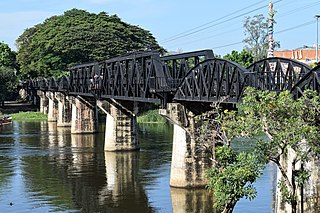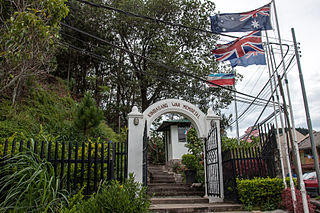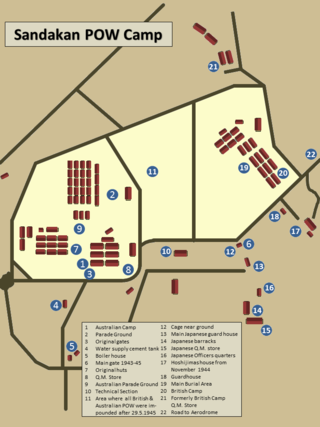
The Burma Railway, also known as the Siam–Burma Railway, Thai–Burma Railway and similar names, or as the Death Railway, is a 415 km (258 mi) railway between Ban Pong, Thailand, and Thanbyuzayat, Burma. It was built from 1940 to 1943 by civilian laborers impressed or recruited by the Japanese and prisoners of war taken by the Japanese, to supply troops and weapons in the Burma campaign of World War II. It completed the rail link between Bangkok, Thailand, and Rangoon, Burma. The name used by the Japanese Government was Tai–Men Rensetsu Tetsudō (泰緬連接鉄道), which means Thailand-Burma-Link-Railway.

Hellfire Pass is the name of a railway cutting on the former Burma Railway in Thailand which was built with forced labour during the Second World War, in part by Allied prisoners of war. The pass is noted for the harsh conditions and heavy loss of life suffered by its labourers during construction. It was called Hellfire Pass because the sight of emaciated prisoners labouring by burning torchlight resembled a scene from Hell.

Sandakan formerly known at various times as Elopura, is the capital of the Sandakan District in Sabah, Malaysia. It is the second largest city in Sabah after Kota Kinabalu. It is located on the Sandakan Peninsula and east coast of the state in the administrative centre of Sandakan Division and was the former capital of British North Borneo. In 2010, the city had an estimated population of 157,330 while the overall municipal area had a total population of 396,290. The population of the municipal area had increased to 439,050 by the 2020 Census.

The Sandakan Death Marches were a series of forced marches in Borneo from Sandakan to Ranau which resulted in the deaths of 2,434 Allied prisoners of war held captive by the Empire of Japan during the Pacific campaign of World War II at the Sandakan POW Camp, North Borneo. By the end of the war, of all the prisoners who had been incarcerated at Sandakan and Ranau, only six Australians survived, all of whom had escaped. It is widely considered to be the single worst atrocity suffered by Australian servicemen during the Second World War.

The Ranau District is an administrative district in the Malaysian state of Sabah, part of the West Coast Division which includes the districts of Kota Belud, Kota Kinabalu, Papar, Penampang, Putatan, Ranau and Tuaran. The capital of the district is in Ranau Town. The landlocked district bordering the Sandakan Division to the east until it meets the Interior Division border. Ranau sits 108 km (67 mi) east of Kota Kinabalu and 227 km (141 mi) west of Sandakan. As of the 2010 Census, the population of the district was 94,092, an almost entirely Dusun ethnic community.

Kundasang is a hill station in the district of Ranau in Sabah, Malaysia that lies along the bank of Kundasang Valley within the Crocker Range, and also neighboring the town of Pekan Nabalu. It is located about 6 kilometres away from Kinabalu National Park, 12 kilometres from Ranau town and is renowned for its vegetable market which is open seven days a week. It is the closest town to Mount Kinabalu and has a panoramic view of the mountain. It is populated mainly by the native Dusun and a small population of Chinese people. Almost all the shops are operated by locals.

Labuan War Cemetery is a Commonwealth World War II graveyard in Labuan, Malaysia.

Nam Tok Sai Yok Noi is a small town in Sai Yok District, Kanchanaburi Province, Thailand, along the route of the Death Railway linking Thailand with Burma. It is named after Sai Yok Noi Waterfall of Sai Yok National Park. During World War II, the small town was known as Tarsoa or Tarsau.

Batu Lintang camp at Kuching, Sarawak on the island of Borneo was a Japanese-run internment camp during the Second World War. It was unusual in that it housed both Allied prisoners of war (POWs) and civilian internees. The camp, which operated from March 1942 until the liberation of the camp in September 1945, was housed in buildings that were originally British Indian Army barracks. The original area was extended by the Japanese, until it covered about 50 acres. The camp population fluctuated, due to movement of prisoners between camps in Borneo, and as a result of the deaths of the prisoners. It had a maximum population of some 3,000 prisoners.

Located in Frankfort, Kentucky, overlooking the state capital, Kentucky Vietnam Veterans Memorial contains the names of 1,108 Kentuckians killed in the Vietnam War. The memorial is in the form of a sundial with the names placed so that the tip of the gnomon's shadow touches each man's name on the date of his death, thus giving each fallen warrior his own personal memorial day.

Before the outbreak of World War II in the Pacific, the island of Borneo was divided into five territories. Four of the territories were in the north and under British control – Sarawak, Brunei, Labuan, an island, and British North Borneo; while the remainder, and bulk, of the island, was under the jurisdiction of the Dutch East Indies.

The Kundasang War Memorial is a memorial located in Kundasang in the Malaysian state of Sabah, which is dedicated to the British and Australian soldiers who died in the Sandakan POW camp during their death marches to Ranau. Besides that, it also recognises the suffering and sacrifice of the native population of Sabah.

The Sandakan camp, also known as Sandakan POW Camp, was a prisoner-of-war camp established during World War II by the Japanese in Sandakan in the Malaysian state of Sabah. This site has gained notoriety as the Sandakan Death Marches started from here. Now, part of the former site houses the Sandakan Memorial Park.

Quailey's Hill Memorial is a memorial in Ranau District, Sabah, Malaysia. It commemorates an Australian POWs, Allan Quailey who been killed on 16 February 1945 during the first Sandakan Death Marches by the Japanese soldiers.

Sandakan Massacre Memorial consists of three monuments which commemorate 30 Chinese victims, most of the members are local elite of an underground movement who been executed on 27 May 1945 along with several other victims during the Japanese occupation of North Borneo. The memorial was built on the spot where the massacre took place and where the victims were buried. It is located near a Chinese cemetery on a hill above the old town centre of Sandakan.

Cho Huan Lai Memorial or also known as Keningau War Memorial in the Malaysian town of Keningau in Sabah is a monument dedicated to Chinese Consul General Cho Huan Lai and his colleagues who died on 6 July 1945 after being executed by the Japanese.

The Sandakan Memorial Park is a memorial site built in the former grounds of the former Sandakan camp in the Malaysian state of Sabah. The site is dedicated as a memory for all prisoners in the camp who died during the Sandakan Death Marches, and to those died during a march to Ranau. It is also recognises the suffering and sacrifice of the native population. This park hosts the Sandakan Memorial Day service on August 15.
Lynette Ramsay Silver, is an Australian historian and author. She has written a number of books dealing with Australian and military history.
Operation Agas was a series of reconnaissance operations carried out by Australia's Z Special Unit in 1945 during the final stages of World War II. This operation was part of the Borneo Campaign, supporting Allied operations to secure North Borneo. Another closely related operation codenamed Semut was carried out in Sarawak. Both operations combined and relayed their intelligence through the Stallion Project to Australian forces and carried out guerrilla warfare against the Japanese in the region with support of the local population. A total of five operations were undertaken, commencing in March 1945, continuing up to September and October 1945.






















